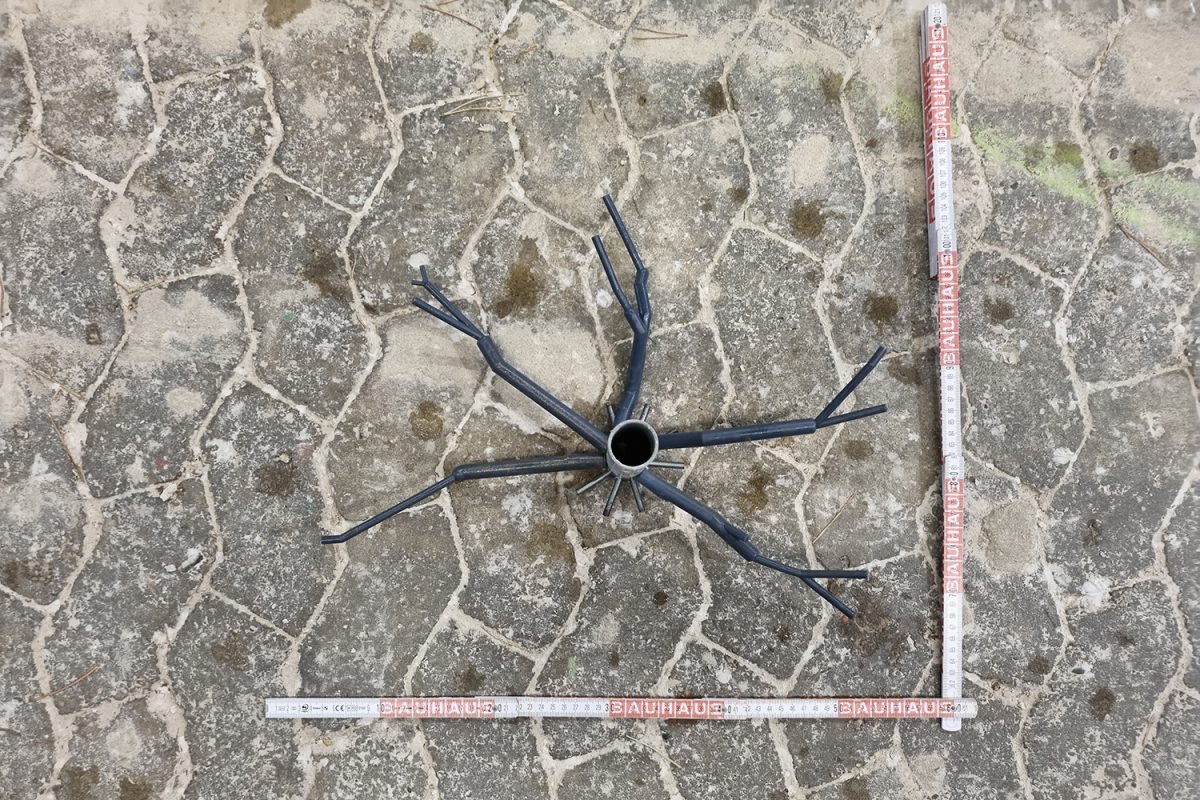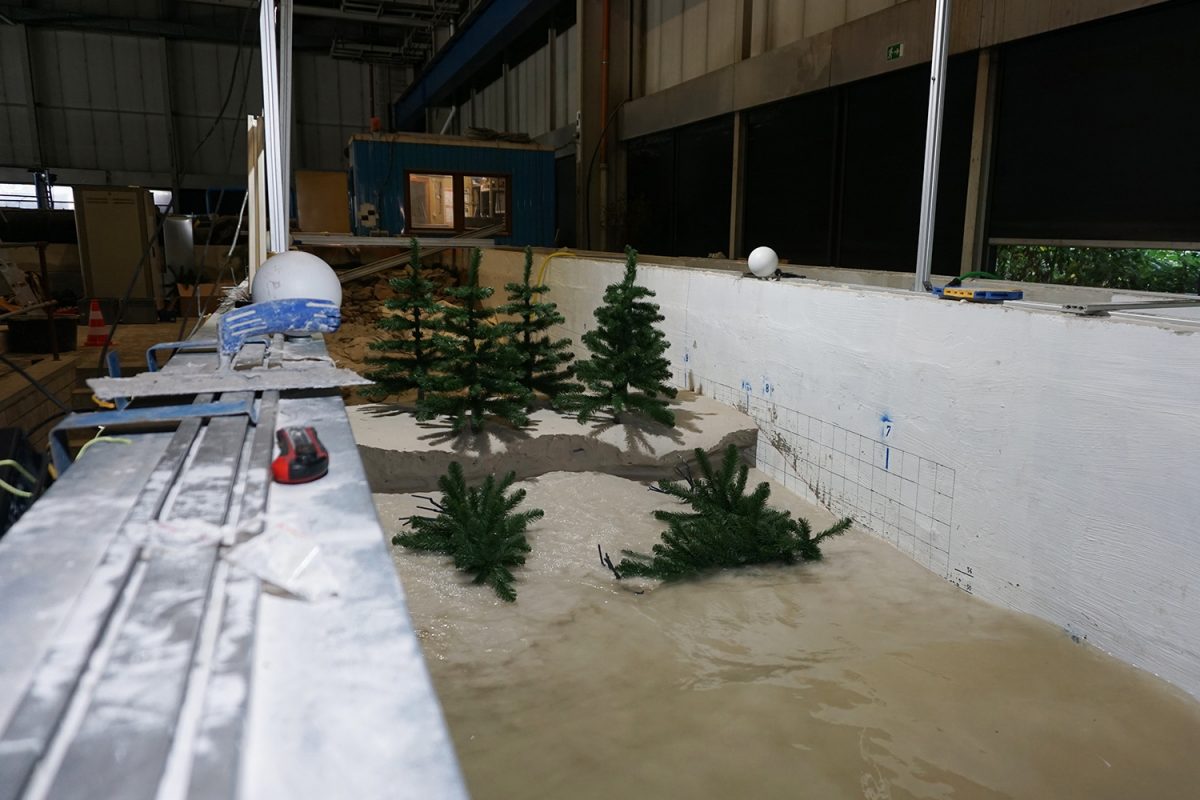Christmas in the wave flume Can dune forests protect the coast from storm surges?
Christmas trees in a wave flume? This unusual sight could be seen a few weeks ago in the experimental hall of the Leichtweiß-Institute for Hydraulic Engineering (LWI) in Braunschweig. Coniferous trees had been placed in one of the flumes. But anyone thinking that the LWI team were celebrating an early Christmas party would be mistaken. The scenario was part of a series of experiments. The scientists were investigating the effect of pine trees on wave-induced dune erosion. The Christmas decorations were, of course, removed for the experiment.

A different kind of experiments in the wave flume – decorated for Christmas. Picture credits: Oliver Lojek/TU Braunschweig
The experiments in the 90 metre long and two metre wide wave flume are part of the final year projects of Johannes Schattmann and Malte Kumlehn. The two civil engineering master’s students are investigating the influence of trees under different storm surge conditions, using both artificial trees and real pines. With their student research projects, they support the research of scientists at the Leichtweiß Institute for Hydraulic Engineering and Water Resources on the adaptation of coastal regions to climate change and accelerated sea level rise.
Sandy Coast of St. Peter-Ording
In the Sandy Coast of St. Peter-Ording project, for example, the scientists have set themselves the goal of developing and implementing a long-term, effective and nature-friendly coastal protection system. Various measures are being implemented to maintain and enhance the biological naturalness and biodiversity of the valuable habitats of this unique coastal landscape, which consists of typical mudflats, dunes, salt marshes and beaches. At the same time, a sustainable approach will be developed to protect the sandy coast from the consequences of accelerated sea-level rise in the future.
The scientists involved in the research network are also investigating the role of the dune forest, which was planted in St. Peter-Ording around 200 years ago to protect the coast and consists mainly of mountain pine and black pine. As part of the project, this non-native coniferous forest is gradually being converted into a mixed forest that is better adapted to climate change.
Artificial Christmas trees as models
As part of their research projects, the two students also explored the dune forest, photographed the root system and – with the permission of the National Park and the support of district forester Patras Scheffler – removed some of the smaller trees. While Malte Kumlehn used the young black pines from the dunes of St. Peter-Ording for his series of experiments, Johannes Schattmann used artificial Christmas trees from the DIY store to replicate the pines. “The model tree offers more flexibility, so the experiments can be repeated several times,” says Johannes Schattmann.
The root system of the five models consists of 3D-printed root strands that were attached to a stable base made of PVC, wood and threaded rods, and then buried in the dune. A conventional plastic Christmas tree was used for the above-ground part. Due to the spatial limitations of the wave flume, the experiments were carried out at a scale of 1:7. The parameters for the test series were based on data from previous investigations in St. Peter-Ording.
8.5 cubic metres of sand for the dune
The model trees were integrated into the profile of a specially constructed sand dune in two different configurations to observe their effect under different conditions. A pure sand dune served as a reference to compare the results with and without the integration of the tree models. Johannes Schattmann, assisted by student assistants from LWI, spread about 8.5 cubic metres of sand in the flume to build the dune. “It took us two to three hours to prepare a test,” he says.

The storm surge in the wave flume has ended. Even though a large part of the dune forest has been knocked over, the observations emphasise that the trees can significantly increase the resistance of dunes against wave attacks. Picture credits: Johannes Schattmann/TU Braunschweig
Improved resistance to erosion
The results of the research show that the model trees were able to reduce the volume of erosion by up to 8.5% in the first storm surge scenario. In this scenario, the wave parameters were chosen to allow the reference dune to withstand the storm surge. The second, much more extreme scenario was designed to ensure that the reference dune was destroyed. In this case, the trees tripled the time it took for the dune to be completely eroded.
Conclusion: These observations emphasise that trees can significantly increase the resistance of dunes to wave attack – they provide stronger protection, especially under extreme conditions. Another result of the experiments: It is not the tree itself that protects the dune. During the experiments, for example, the front rows of trees fell over, which in turn can act as breakwaters. It is mainly the fine root network that contributes to erosion protection.
“The study and realistic modelling of such coastal protection systems is extremely important in order to better understand the complex interactions between vegetation, dunes and wave action,” says Johannes Schattmann.










